St. Augustine, Florida
St. Augustine
San Agustín (Spanish) | |
|---|---|
City | |
| City of Saint Augustine | |
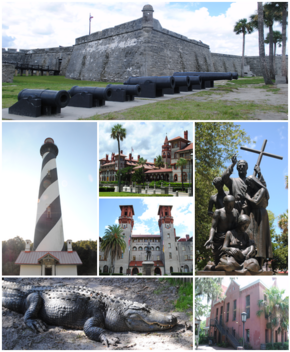 Top, left to right: Castillo de San Marcos, St. Augustine Light, Flagler College, Lightner Museum, statue near the Cathedral Basilica of St. Augustine, St. Augustine Alligator Farm Zoological Park, Old St. Johns County Jail | |
 Coat of arms | |
| Nickname(s): Ancient City, Old City | |
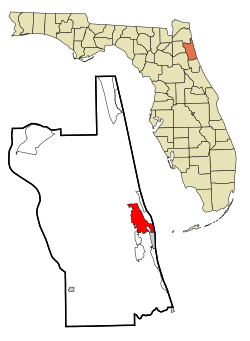 Location in St. Johns County and the U.S. state of Florida | |
 St. Augustine Location in the United States | |
| Coordinates: 29°53′41″N 81°18′52″W / 29.89472°N 81.31444°WCoordinates: 29°53′41″N 81°18′52″W / 29.89472°N 81.31444°W[1] | |
| Country | |
| State | |
| County | |
| Established | September 8, 1565 |
| Founded by | Pedro Menéndez de Avilés |
| Named for | Saint Augustine of Hippo |
| Government | |
| • Type | City commission government |
| • Mayor | Tracy Upchurch (R) |
| Area | |
| • City | 12.85 sq mi (33.29 km2) |
| • Land | 9.52 sq mi (24.66 km2) |
| • Water | 3.33 sq mi (8.63 km2) |
| Elevation | 0 ft (0 m) |
| Population | |
| • City | 12,975 |
| • Estimate (2019)[5] | 15,415 |
| • Density | 1,619.05/sq mi (625.09/km2) |
| • Urban | 69,173 (US: 399th) |
| Time zone | UTC−5 (EST) |
| • Summer (DST) | UTC−4 (EDT) |
| ZIP code(s) | 32080, 32084, 32085, 32086, 32095, 32082, 32092 |
| Area code(s) | 904 |
| FIPS code | 12-62500[6] |
| GNIS feature ID | 0308101[3] |
| Website | City of St. Augustine |
St. Augustine (from Spanish: San Agustín) is a city in the Southeastern United States, on the Atlantic coast of northeastern Florida. Founded in 1565 by Spanish explorers, it is the oldest continuously-inhabited European-established settlement in the contiguous United States.
St. Augustine was founded on September 8, 1565, by Spanish admiral Pedro Menéndez de Avilés, Florida's first governor. He named the settlement "San Agustín", as his ships bearing settlers, troops, and supplies from Spain had first sighted land in Florida eleven days earlier on August 28, the feast day of St. Augustine.[7] The city served as the capital of Spanish Florida for over 200 years. It was designated as the capital of British East Florida when the colony was established in 1763; Great Britain returned Florida to Spain in 1783.
Spain ceded Florida to the United States in 1819, and St. Augustine was designated the capital of the Florida Territory upon ratification of the Adams–Onís Treaty in 1821. The Florida National Guard made the city its headquarters that same year. The territorial government moved and made Tallahassee the capital of Florida in 1824.
The county seat of St. Johns County, St. Augustine is part of Florida's First Coast region and the Jacksonville metropolitan area. Since the late 19th century, St. Augustine's distinct historical character has made the city a tourist attraction.
History[]
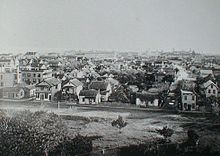

Founding by Pedro Menéndez de Avilés[]
Founded in 1565 by the Spanish conquistador Pedro Menéndez de Avilés, St. Augustine is the oldest continuously occupied settlement of European origin in the contiguous United States.[8][9] It is the second-oldest continuously inhabited city of European origin in United States territory after San Juan, Puerto Rico (founded in 1521).[10] It is also contained earliest-known Black community in the same territory, among whom many or most were freedmen.[11]
In 1560, King Philip II of Spain appointed Menéndez as Captain General, and his brother Bartolomé Menéndez as Admiral, of the Fleet of the Indies.[12] Thus Pedro Menéndez commanded the galleons of the great Armada de la Carrera, or Spanish Treasure Fleet, on their voyage from the Caribbean and Mexico to Spain, and determined the routes they followed.
In early 1564 he asked permission to go to Florida to search for La Concepcion, the galeon Capitana, or flagship, of the New Spain fleet commanded by his son, Admiral Juan Menéndez. The ship had been lost in September 1563 when a hurricane scattered the fleet as it was returning to Spain, at the latitude of Bermuda off the coast of South Carolina.[13] The crown repeatedly refused his request.
In 1565, however, the Spanish decided to destroy the French outpost of Fort Caroline, located in what is now Jacksonville. The crown approached Menéndez to fit out an expedition to Florida[14] on the condition that he explore and settle the region as King Philip's adelantado, and eliminate the Huguenot French,[15] whom the Catholic Spanish considered to be dangerous heretics.[16]
Menéndez was in a race to reach Florida before the French captain Jean Ribault,[17] who was on a mission to secure Fort Caroline. On August 28, 1565, the feast day of St. Augustine of Hippo, Menéndez's crew finally sighted land; the Spaniards continued sailing northward along the coast from their landfall, investigating every inlet and plume of smoke along the shore. On September 4, they encountered four French vessels anchored at the mouth of a large river (the St. Johns), including Ribault's flagship, La Trinité. The two fleets met in a brief skirmish, but it was not decisive. Menéndez sailed southward and landed again on September 8, formally declared possession of the land in the name of Philip II, and officially founded the settlement he named San Agustín (Saint Augustine).[18][19] At the landing spot, Father Francisco López de Mendoza Grajales celebrated the first Catholic mass offered in the colony.[20][21][22] The settlement was built in the former Timucua village of Seloy; its location was chosen for its defensibility and proximity to a fresh water artesian spring.
A French attack on St. Augustine was thwarted by a violent squall that ravaged the French naval forces. Taking advantage of this, Menéndez marched his troops overland to Fort Caroline on the St. Johns River, about 30 miles (50 km) north. The Spanish easily overwhelmed the lightly defended French garrison, which had been left with only a skeleton crew of 20 soldiers and about 100 others, killing most of the men and sparing about 60 women and children. The bodies of the victims were hung in trees with the inscription: "Hanged, not as Frenchmen, but as "Lutherans" (heretics)."[23][24] Menéndez renamed the fort San Mateo and marched back to St. Augustine, where he discovered that the shipwrecked survivors from the French ships had come ashore to the south of the settlement. A Spanish patrol encountered the remnants of the French force, and took them prisoner. Menéndez accepted their surrender, but then executed all of them except a few professing Catholics and some Protestant workers with useful skills, at what is now known as Matanzas Inlet (Matanzas is Spanish for "slaughters").[25] The site is very near the national monument Fort Matanzas, built in 1740-1742 by the Spanish.
Invasions by pirates and enemies of Spain[]
Succeeding governors of the province maintained a peaceful coexistence with the local Native Americans, allowing the isolated outpost of St. Augustine some stability for a few years. On May 28 and 29, 1586, soon after the Anglo-Spanish War began between England and Spain, the English privateer Sir Francis Drake sacked and burned St. Augustine.[26] The approach of his large fleet obliged Governor Pedro Menéndez Márquez and the townspeople to evacuate the settlement. When the English got ashore, they seized some artillery pieces and a royal strongbox containing gold ducats (which was the garrison payroll).[27] The killing of their sergeant major by the Spanish rearguard caused Drake to order the town razed to the ground.[28][29]
In 1609 and 1611, expeditions were sent out from St. Augustine against the English colony at Jamestown.[30] In the second half of the 17th century, groups of Indians from the colony of Carolina conducted raids into Florida and killed the Franciscan priests who served at the Catholic missions. Requests by successive governors of the province to strengthen the presidio’s garrison and fortifications were ignored by the Spanish Crown which had other priorities in its vast empire. The charter of 1663 for the new Province of Carolina, issued by King Charles II of England, was revised in 1665, claiming lands as far southward as 29 degrees north latitude, about 65 miles south of the existing settlement at St. Augustine.[31][32]
The English buccaneer Robert Searle sacked St. Augustine in 1668, after capturing some Spanish supply vessels bound for the settlement and holding their crews at gun point while his men hid below decks. Searle was retaliating for the Spanish destruction of the settlement of New Providence in the Bahamas. Searle and his men killed sixty people and pillaged public storehouses, churches and houses.[33] This raid and the establishment of the English settlement at Charles Town spurred the Spanish Crown to finally acknowledge the vulnerability of St. Augustine to foreign incursions and strengthen the city's defenses. In 1669, Queen Regent Mariana ordered the Viceroy of New Spain to disburse funds for the construction of a permanent masonry fortress, which began in 1672.[34] Before the fortress was completed, French buccaneers Michel de Grammont and Nicolas Brigaut planned an ill-fated attack in 1686 which was foiled: their ships were run aground, Grammont and his crew were lost at sea, and Brigaut was captured ashore by Spanish soldiers.[35] The Castillo de San Marcos was completed in 1695, not long before an attack by James Moore's forces from Carolina in November, 1702. Failing to capture the fort after a siege of 58 days, the British set St. Augustine ablaze as they retreated.[36]
In 1738, the governor of Spanish Florida, Manuel de Montiano, ordered a settlement be constructed two miles north of St. Augustine for the growing Free Black community established by fugitive slaves who had escaped into Florida from the Thirteen Colonies. This new community, Fort Mose, would serve as a military outpost and buffer for St. Augustine, as the men accepted into Fort Mose had enlisted in the colonial militia and converted to Catholicism in exchange for their freedom.[37][38]
In 1740, however, St. Augustine was again besieged, this time by the governor of the British colony of Georgia, General James Oglethorpe, who was also unable to take the fort.[39]
Loyalist haven under British rule[]
The 1763 Treaty of Paris, signed after Great Britain's victory over France and Spain during the Seven Years' War, ceded Florida to Great Britain in exchange for the return of Havana and Manila. The vast majority of Spanish colonists in the region left Florida for Cuba, Florida became Great Britain's fourteenth and fifteenth North American colonies, and because of the political sympathies of its British inhabitants, St. Augustine became a Loyalist haven during the American Revolutionary War.[40]
After the mass exodus of St. Augustinians, Great Britain sought to repopulate its new colony. The London Board of Trade advertised 20,000-acre lots to any group that would settle in Florida within ten years, with one resident per 100 acres. Pioneers who were "energetic and of good character" were given 100 acres of land and 50 additional acres for each family member they brought. Under Governor James Grant, almost three million acres of land were granted in East Florida alone. Second stories were added to existing Spanish homes and new houses were built. Cattle ranching and plantation agriculture began to thrive.[41]
During the twenty-year period of British rule, Britain took command of both the Castillo de San Marcos (renamed Fort St. Mark) and of Fort Matanzas. They permanently stationed a small group of men at Fort Matanzas. Once war broke out, loyalist St. Augustine residents burned effigies of Patriots Samuel Adams and John Hancock in the plaza. Fort St. Mark became a training and supply base, as well a prisoner-of-war camp where three signers of the Declaration of Independence and South Carolina's lieutenant governor Christopher Gadsden were held. Local militia composed of Florida, Georgia, and Carolina inhabitants formed the East Florida Rangers in 1776 and were reorganized to form the King's Rangers in 1779.[41] Spanish General Bernardo de Gálvez, harassed the British in West Florida and captured Pensacola. Fears that the Spanish would then move to capture St. Augustine, however, proved unfounded.[42]
The 1783 Treaty of Paris, which recognized the independence of the Thirteen Colonies as the United States, ceded Florida back to Spain and returned the Bahamas to Britain. As a result, some of the town's Spanish residents returned to St Augustine. Refugees from Dr. Andrew Turnbull's troubled colony in New Smyrna had fled to St. Augustine in 1777, made up the majority of the city's population during the period of British rule, and remained when the Spanish Crown took control again. This group was, and still is, referred to locally as "Menorcans", even though it also included settlers from Italy, Corsica and the Greek islands.[43][44]
Second Spanish period[]
During the Second Spanish period (1784–1821) of Florida, Spain was dealing with invasions of the Iberian peninsula by Napoleon's armies in the Peninsular War, and struggled to maintain a tenuous hold on its territories in the western hemisphere as revolution swept South America. The royal administration of Florida was neglected, as the province had long been regarded as an unprofitable backwater by the Crown. The United States, however, considered Florida vital to its political and military interests as it expanded its territory in North America, and maneuvered by sometimes clandestine means to acquire it.[45] The Adams–Onís Treaty, negotiated in 1819 and ratified in 1821, ceded Florida and St. Augustine, still its capital at the time, to the United States.[46]
Territory of Florida[]
According to the Adams–Onís Treaty, the United States acquired East Florida and absolved Spain of $5 million of debt. Spain renounced all claims to West Florida and the Oregon Country. Andrew Jackson returned to Florida in 1821, upon ratification of the treaty, and established a new territorial government. Americans from older plantation societies of Virginia, Georgia, and the Carolinas began to move to the area. West Florida was quickly consolidated with East and the new capital of Florida became Tallahassee, halfway between the old capitals of St. Augustine and Pensacola, in 1824.[47]
Once many Americans had begun to immigrate to the new territory, it became apparent that there would be continued skirmishes with local Creek and Miccosukee peoples and white settlers encroaching on their land. The United States government favored removal policies, but local indigenous groups in Florida refused to leave without fighting. The nineteenth century saw three Seminole Wars. In 1823, territorial governor William Duval and James Gadsden signed the Treaty of Moultrie Creek, forcing Seminoles onto a four million acre reservation in central Florida. The Second Seminole War (1835–1842) was the longest war of Indian removal and resulted when the United States government attempted to move the Seminole people from Central Florida to a Creek reservation west of the Mississippi River. As a result of the Seminole War, Seminole prisoners were held captive in the Castillo de San Marcos, renamed Fort Marion after General Francis Marion, who fought in the American Revolution, in the 1830s.[47]
By 1840, the territory's population had reached 54,477 people. Half the population were enslaved Africans. Steamboats were popular on the Apalachicola and St. Johns River and there were several plans for railroad construction. The territory south of present-day Gainesville was sparsely populated by whites.[47]
In 1845 the Florida Territory was admitted into the Union as the State of Florida.[48]
Civil War[]

Florida joined the Confederacy after the Civil War began in 1861, and Confederate authorities remained in control of St. Augustine for fourteen months, although it was barely defended. The Union conducted a blockade of shipping. In 1862 Union troops gained control of St. Augustine and controlled it through the rest of the war. With the economy already suffering, many residents fled.[49][50]
Henry Flagler and the railroad[]
Henry Flagler, a co-founder with John D. Rockefeller of the Standard Oil Company, spent the winter of 1883 in St. Augustine and found the city charming, but considered its hotels and transportation systems inadequate.[51] He had the idea to make St. Augustine a winter resort for wealthy Americans from the north, and to bring them south he bought several short line railroads and combined these in 1885 to form the Florida East Coast Railway. He built a railroad bridge over the St. Johns River in 1888, opening up the Atlantic coast of Florida to development.[52][53]
Flagler finished construction in 1887 on two large ornate hotels in the city, the 450-room Hotel Ponce de Leon and the 250-room Hotel Alcazar. The next year, he purchased the Casa Monica Hotel (renaming it the Cordova Hotel) across the street from both the Alcazar and the Ponce de Leon. His chosen architectural firm, Carrère and Hastings, radically altered the appearance of St. Augustine with these hotels, giving it a skyline and beginning an architectural trend in the state characterized by the use of the Spanish Renaissance Revival and Moorish Revival styles. With the opening of the Ponce de Leon in 1888, St. Augustine became the winter resort of American high society for a few years.[54]
When Flagler's Florida East Coast Railroad was extended southward to Palm Beach and then Miami in the early 20th century, the wealthy stopped in St. Augustine en route to the southern resorts. Wealthy vacationers began to customarily spend their winters in South Florida, where the climate was warmer and freezes were rare. St. Augustine nevertheless still attracted tourists, and eventually became a destination for families traveling in automobiles as new highways were built and Americans took to the road for annual summer vacations. The tourist industry soon became the dominant sector of the local economy.[55]
Civil Rights Movement[]
In late 1963, nearly a decade after the Supreme Court ruling in Brown v. Board of Education that segregation of schools was unconstitutional, African Americans were still trying to get St. Augustine to integrate the public schools in the city. They were also trying to integrate public accommodations, such as lunch counters,[56] and were met with arrests[57] and Ku Klux Klan violence.[58][59] Local college students held non-violent protests throughout the city, including sit-ins at the local Woolworth's, picket lines, and marches through the downtown. These protests were often met with police violence. Homes of African Americans were firebombed,[60] black leaders were assaulted and threatened with death, and others were fired from their jobs.
In the spring of 1964, St. Augustine civil rights leader Robert Hayling[61] asked the Southern Christian Leadership Conference (SCLC) and its leader Martin Luther King Jr. for assistance.[62] From May until July 1964, King and Hayling, along with Andrew Young, organized marches, sit-ins, and other forms of peaceful protest in St. Augustine. Hundreds of black and white civil rights supporters were arrested,[63] and the jails were filled to capacity.[64] At the request of Hayling and King, white civil rights supporters from the North, including students, clergy, and well-known public figures, came to St. Augustine and were arrested together with Southern activists.[65][66][67]
St. Augustine was the only place in Florida where King was arrested; his arrest there occurred on June 11, 1964, on the steps of the Monson Motor Lodge's restaurant. The demonstrations came to a climax when a group of black and white protesters jumped into the hotel's segregated swimming pool. In response to the protest, James Brock, the manager of the hotel and the president of the Florida Hotel & Motel Association, poured what he claimed to be muriatic acid into the pool to burn the protesters. Photographs of this, and of a policeman jumping into the pool to arrest the protesters, were broadcast around the world.
The Ku Klux Klan responded to these protests with violent attacks that were widely reported in national and international media.[68] Popular revulsion against the Klan and police violence in St. Augustine generated national sympathy for the black protesters and became a key factor in Congressional passage of the Civil Rights Act of 1964,[69] leading eventually to passage of the Voting Rights Act of 1965,[70] both of which provided federal enforcement of constitutional rights.
Modern St. Augustine[]
In 1965, St. Augustine celebrated the 400th anniversary of its founding,[71] and jointly with the State of Florida, inaugurated a program to restore part of the colonial city. The Historic St. Augustine Preservation Board was formed to reconstruct more than thirty-six buildings to their historical appearance, which was completed within a few years. When the State of Florida abolished the Board in 1997, the City of St. Augustine assumed control of the reconstructed buildings, as well as other historic properties including the Government House. In 2010, the city transferred control of the historic buildings to UF Historic St. Augustine, Inc., a direct support organization of the University of Florida.
In 2015, St. Augustine celebrated the 450th anniversary of its founding with a four-day long festival and a visit from Felipe VI of Spain and Queen Letizia of Spain.[72]
On October 7, 2016 Hurricane Matthew caused widespread flooding in downtown St. Augustine.[73]
Geography and climate[]
This section needs additional citations for verification. (October 2016) |
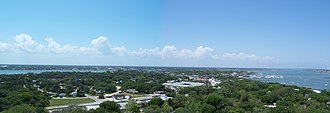
St. Augustine is located at 29°53′41″N 81°18′52″W / 29.89472°N 81.31444°W (29.8946910, −81.3145170). According to the United States Census Bureau, the city has a total area of 10.7 square miles (27.8 km2), 8.4 square miles (21.7 km2) of which is land and 2.4 square miles (6.1 km2) (21.99%) is water. Access to the Atlantic Ocean is via the St. Augustine Inlet of the Matanzas River.
St. Augustine has a humid subtropical climate (Cfa) typical of the Gulf and South Atlantic states. The low latitude and coastal location give the city a mostly warm and sunny climate. Unlike much of the contiguous United States, St. Augustine's driest time of year is winter. The hot and wet season extends from May through October, while the cool and dry season extends November through April.
In summer, highs are in the 80s to 90s and lows are in the 70s. The Bermuda High pumps in hot and unstable tropical air from the Bahamas and Gulf of Mexico, which help create the daily thundershowers that are typical in summer months. Intense but very brief downpours are common in summer in the city. Fall and spring are warm and sunny with highs from 74 °F to 87 °F and lows in the 50s to 70s.
In winter, St. Augustine has generally mild and sunny weather typical of the Florida peninsula. The coolest months are from December through February, with highs from 67 °F to 70 °F and lows from 47 °F to 51 °F. From November through April, St. Augustine often has long periods of rainless weather. April can see near drought conditions with brush fires and water restrictions in place. St. Augustine averages 4.6 frosts per year. The record low of 10 °F (−12 °C) happened on January 21, 1985. Hurricanes occasionally impact the region; however, like most areas prone to such storms, St. Augustine rarely suffers a direct hit by a major hurricane. The last direct hit by a major hurricane to the city was Hurricane Dora in 1964. Extensive flooding occurred in the downtown area of St. Augustine when Hurricane Matthew passed east of the city in October 2016.[74]
| hideClimate data for St. Augustine, Florida (St. Augustine Light), 1991-2020 normals, extremes 1973-2016 | |||||||||||||
|---|---|---|---|---|---|---|---|---|---|---|---|---|---|
| Month | Jan | Feb | Mar | Apr | May | Jun | Jul | Aug | Sep | Oct | Nov | Dec | Year |
| Record high °F (°C) | 86 (30) |
87 (31) |
93 (34) |
95 (35) |
98 (37) |
101 (38) |
103 (39) |
101 (38) |
99 (37) |
94 (34) |
89 (32) |
86 (30) |
103 (39) |
| Average high °F (°C) | 67.5 (19.7) |
69.7 (20.9) |
74.4 (23.6) |
79.8 (26.6) |
85.1 (29.5) |
88.6 (31.4) |
91.0 (32.8) |
89.9 (32.2) |
87.4 (30.8) |
81.8 (27.7) |
74.9 (23.8) |
68.9 (20.5) |
79.9 (26.6) |
| Daily mean °F (°C) | 57.6 (14.2) |
60.0 (15.6) |
64.5 (18.1) |
70.2 (21.2) |
76.3 (24.6) |
80.4 (26.9) |
82.4 (28.0) |
82.1 (27.8) |
80.3 (26.8) |
74.2 (23.4) |
66.2 (19.0) |
60.1 (15.6) |
71.2 (21.8) |
| Average low °F (°C) | 47.8 (8.8) |
50.2 (10.1) |
54.6 (12.6) |
60.6 (15.9) |
67.4 (19.7) |
72.3 (22.4) |
73.8 (23.2) |
74.2 (23.4) |
73.1 (22.8) |
66.5 (19.2) |
57.5 (14.2) |
51.3 (10.7) |
62.4 (16.9) |
| Record low °F (°C) | 10 (−12) |
21 (−6) |
23 (−5) |
34 (1) |
41 (5) |
52 (11) |
59 (15) |
61 (16) |
54 (12) |
36 (2) |
29 (−2) |
16 (−9) |
10 (−12) |
| Average precipitation inches (mm) | 2.74 (70) |
2.69 (68) |
3.43 (87) |
2.93 (74) |
3.66 (93) |
6.27 (159) |
4.88 (124) |
7.18 (182) |
7.18 (182) |
4.37 (111) |
2.32 (59) |
2.99 (76) |
50.64 (1,286) |
| Average precipitation days (≥ 0.01 in) | 9.4 | 7.8 | 8.6 | 6.8 | 7.2 | 12.3 | 11.6 | 15.0 | 13.5 | 9.1 | 8.1 | 8.4 | 117.8 |
| Source: NOAA[75][76] | |||||||||||||
Demographics[]
| Historical population | |||
|---|---|---|---|
| Census | Pop. | %± | |
| 1830 | 1,708 | — | |
| 1840 | 2,450 | 43.4% | |
| 1850 | 1,934 | −21.1% | |
| 1860 | 1,914 | −1.0% | |
| 1870 | 1,717 | −10.3% | |
| 1880 | 2,293 | 33.5% | |
| 1890 | 4,742 | 106.8% | |
| 1900 | 4,272 | −9.9% | |
| 1910 | 5,494 | 28.6% | |
| 1920 | 6,192 | 12.7% | |
| 1930 | 12,111 | 95.6% | |
| 1940 | 12,090 | −0.2% | |
| 1950 | 13,555 | 12.1% | |
| 1960 | 14,734 | 8.7% | |
| 1970 | 12,352 | −16.2% | |
| 1980 | 11,985 | −3.0% | |
| 1990 | 11,692 | −2.4% | |
| 2000 | 11,592 | −0.9% | |
| 2010 | 12,975 | 11.9% | |
| 2019 (est.) | 15,415 | [5] | 18.8% |
| U.S. Decennial Census[77] | |||
As of the 2010 United States Census, there were 12,975 people, 5,743 households, and 2,679 families residing in the city. The population density was 1,376.2 people per square mile (531/km2). There were 6,978 housing units at an average density of 549.4 per square mile (211.4/km2). The racial makeup of the city was 84.2% white, 11.6% African American, 0.4% Native American, 1.2% Asian, 0.1% Pacific Islander, 0.8% from other races, and 1.6% from two or more races. Hispanic or Latino of any race were 5.1% of the population.
There were 5,743 households, out of which 14.6% had children under the age of 18 living with them, 31.7% were married couples living together, 10.9% had a female householder with no husband present, and 53.4% were non-families. 37.8% of all households were made up of individuals, and 14.4% had someone living alone who was 65 years of age or older. The average household size was 2.03 and the average family size was 2.67.
In the city, 13.1% of the population was under the age of 18, 15.3% from 18 to 24, 23.9% from 25 to 44, 25.2% from 45 to 64, and 19% who were 65 years of age or older. The median age was 42.6 years. For every 100 females, there were 88.1 males. For every 100 females age 18 and over, there were 85.8 males.
The median income for a household in the city was $36,424, and the median income for a family was $56,055. Males had a median income of $32,409 versus $30,188 for females. The per capita income for the city was $23,485. About 7.6% of families and 21.1% of the population were below the poverty line, including 18.8% of those under age 18 and 24.4% of those age 65 or over.
The United States Census Bureau's 2013 estimate of the city's population was 13,679, while the urban area had a population of 71,379 in 2012.[78]
Government and politics[]
St. Augustine is the county seat of St. Johns County, Florida.[79][80]
The city of St. Augustine operates under a city commission government form with an elected mayor, vice mayor, and city commission. Additionally, the government includes a city manager, city attorney, city clerk, and various city boards.[81]
Transportation[]
Highways[]
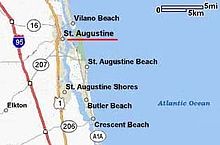
 Interstate 95 runs north–south.
Interstate 95 runs north–south. U.S. Route 1 runs north–south.
U.S. Route 1 runs north–south. State Road A1A runs north–south.
State Road A1A runs north–south. State Road 16 runs east–west
State Road 16 runs east–west State Road 207 runs northeast–southwest
State Road 207 runs northeast–southwest State Road 312 runs east–west
State Road 312 runs east–west
Buses[]
Bus service is operated by the Sunshine Bus Company. Buses operate mainly between shopping centers across town, but a few go to Hastings and Jacksonville, where one can connect to JTA for additional service across Jacksonville.
Airport[]
St. Augustine has one public airport 4 miles (6.4 km) north of the downtown. It has three runways and two seaplane lanes.[82] There is currently no scheduled service to the Airport following ViaAir’s suspension of service to Charlotte in 2018. Various private jets and tour helicopters also operate from the airport. Northrop Grumman runs a large manufacturing plant on the grounds, where the E-2 Hawkeye is produced. Jacksonville International Airport is 40 miles to the north along I-95.
Points of interest[]
First and second Spanish eras[]
- Avero House
- Castillo de San Marcos National Monument
- Fort Matanzas National Monument
- Fort Mose Historic State Park
- Nombre de Dios
- Gonzalez-Alvarez House
- Fountain of Youth Archaeological Park
- The Spanish Military Hospital Museum
- St. Francis Barracks
- Colonial Quarter
- Ximenez-Fatio House
- González-Jones House
- Llambias House
- Oldest Wooden Schoolhouse
- Tolomato Cemetery and Huguenot Cemetery
British era[]
Pre-Flagler era[]
- St. Augustine Lighthouse and Museum
- Markland Mansion
Flagler era[]
- Ponce de Leon Hotel
- Casa Monica Hotel
- Hotel Alcazar
- Zorayda Castle
- Bridge of Lions
- Old St. Johns County Jail
- Ripley's Believe it or Not! Museum located in 1887 mansion of William Worden.
- St. Augustine Alligator Farm Zoological Park
Historic churches[]
- Grace United Methodist Church
- Cathedral Basilica of St. Augustine
- Memorial Presbyterian Church
- Trinity Church of St. Augustine
Lincolnville National Historic District – Civil Rights era[]
Other points of interest[]
- Anastasia State Park
- Florida School for the Deaf and Blind
- St. Augustine Amphitheatre
- St. Augustine Pirate & Treasure Museum
- World Golf Hall of Fame
- Great Cross
Education[]

Primary and secondary education in St. Augustine is overseen by the St. Johns County School District. There are no county high schools located within St. Augustine's current city limits, but St. Augustine High School, Pedro Menendez High School, and St. Johns Technical High School are located in the vicinity. The Florida School for the Deaf and Blind, a state-operated boarding school for deaf and blind students, was founded in the city in 1885.[83] The Catholic Diocese of St. Augustine operates the St. Joseph Academy, Florida's oldest Catholic high school, to the west of the city.[84]
There are several institutions of higher education in and around St. Augustine. Flagler College is a four-year liberal arts college founded in 1968. It is located in the former Ponce de Leon Hotel in downtown St. Augustine.[85] St. Johns River State College, a state college in the Florida College System, has its St. Augustine campus just west of the city. Also in the area are the University of North Florida, Jacksonville University, and Florida State College at Jacksonville in Jacksonville.[86]
The institution now known as Florida Memorial University was located in St. Augustine from 1918 to 1968, when it relocated to its present campus in Miami. Originally known as Florida Baptist Academy, then Florida Normal, and then Florida Memorial College, it was a historically black institution and had a wide impact on St. Augustine while it was located there. During World War II it was chosen as the site for training the first blacks in the U. S. Signal Corps. Among its faculty members was Zora Neale Hurston; a historic marker is placed at the house where she lived while teaching at Florida Memorial[87] (and where she wrote her autobiography Dust Tracks on a Road.)[88][89]
Notable people[]
This section needs additional citations for verification. (August 2018) |

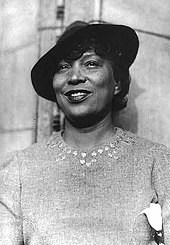
- Andrew Anderson, physician, St. Augustine mayor
- John Alexander Armstrong, political theorist and scholar
- Murray Armstrong, hockey coach
- Pete Banaszak, professional football player[90]
- Frances Bemis, public relations specialist
- Jorge Biassou, Haitian revolutionary and first black American general
- Richard Boone, actor
- James Branch Cabell, novelist
- Doug Carn, jazz musician
- Cris Carpenter, Major League baseball player
- Ray Charles, pianist, singer, composer
- George J. F. Clarke, Surveyor General of Spanish East Florida
- Nicholas de Concepcion, escaped slave who became a Spanish privateer and pirate captain
- Earl Cunningham, artist
- Alexander Darnes, born a slave, became a celebrated physician
- Edmund Jackson Davis, governor of Texas
- Frederick Delius, composer
- Henry Flagler, industrialist
- Willie Galimore, football player
- Michael Gannon, historian
- Laura Jane Grace, singer
- William H. Gray, U.S. congressman and president of the United Negro College Fund
- Martin Davis Hardin, Union General in the Civil War
- Robert Hayling, civil rights leader
- Hurley Haywood endurance race car driver[91]
- Martin Johnson Heade, artist
- Louise Homer, opera singer
- Sidney Homer, composer
- Jack D. Hunter, novelist, author of The Blue Max
- Zora Neale Hurston, novelist and folklorist
- Lindy Infante, professional football coach
- Willie Irvin, professional football player
- Brandon James, professional football player
- Stetson Kennedy, author and human rights activist
- Jack Temple Kirby, historian
- LaChanze, Tony Award & Emmy Award winning actor, singer, and dancer
- Scott Lagasse Jr., race car driver
- Charlie LaPradd, college football player, college president
- Eugene Levy, actor, comedian, producer, director, and writer
- Jacob Lawrence, artist
- Sinclair Lewis, novelist
- John C. Lilly, neuroscientist, developer of the isolation tank
- William W. Loring, Confederate general
- Mary MacLane, author
- Albert Manucy, historian, author, Fulbright Scholar
- George McGovern, U.S. Senator, presidential candidate
- Howell W. Melton, United States district judge
- Howell W. Melton Jr., attorney, law firm managing partner
- Johnny Mize, Hall of Fame baseball player
- Prince Achille Murat, nephew of Napoleon Bonaparte
- David Nolan, author and historian
- Ashley Ann Olsen, murder victim
- Osceola, Seminole War leader (held prisoner at Fort Marion, now Castillo de San Marcos)
- Tom Petty, rock musician
- Scott Player, professional football punter
- Verle A. Pope, state legislator
- Richard Henry Pratt, soldier and educator
- Marjorie Kinnan Rawlings, novelist
- Marcus Roberts, musician
- Gamble Rogers, folk singer
- John M. Schofield, Union general
- Steven L. Sears, television writer-producer
- Sheamus, Irish professional wrestler
- Edmund Kirby Smith, Confederate general
- Dale Snodgrass - United States Navy avaiator and air show performer who was considered one of the greatest fighter pilots of all time.[92]
- Steve Spurrier, college/pro (American) football coach
- Caleb Sturgis, NFL kicker
- Peter Taylor, novelist
- Travis Tomko, professional wrestler
- The Wobbly Toms, music group
- Felix Varela, Cuban national hero
- Augustin Verot, first Bishop of St. Augustine
- Patty Wagstaff, aerobatic pilot
- DeWitt Webb, physician, St. Augustine mayor, state representative
- David Levy Yulee, first Jewish U.S. Senator, Levy County and Yulee, Florida namesake
Sister cities[]
St. Augustine's sister cities are:[93]
 Avilés, Spain
Avilés, Spain Cartagena, Colombia
Cartagena, Colombia Menorca, Spain
Menorca, Spain Santo Domingo, Dominican Republic
Santo Domingo, Dominican Republic
Gallery[]

Bell tower on northeast bastion of the Castillo de San Marcos

North bastions and wall of the Castillo, looking eastward toward Anastasia Island
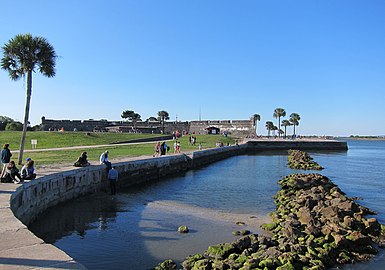
Seawall south of the Castillo
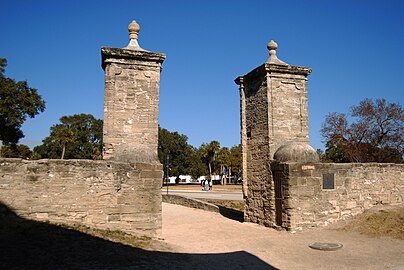
The city gates of St. Augustine, built in 1808, part of the much older Cubo Line

The Government House. East wing of the building dates to the 18th-century structure built on original site of the colonial governor's residence.[94]

Facade of the Roman Catholic Cathedral of St. Augustine
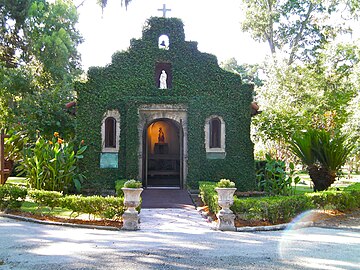
Shrine of Our Lady of La Leche at Mission Nombre de Dios

Statue of Ponce de León

Memorial Presbyterian Church

The former Hotel Alcazar now houses the Lightner Museum and City Hall

Bridge of Lions, looking eastward to Anastasia Island
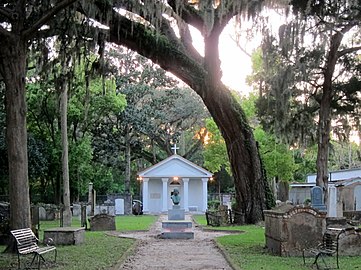
Tolomato Cemetery
See also[]
- Recent scholarship has revealed that the first recorded St. Patrick's Day celebration in what is now the United States was held at St. Augustine in March 1601; according to Michael Francis's 2017 research in the Spanish Archives of the Indies (Archivo General de Indias), the citizens of St. Augustine marched on that date in a procession to honor the feast day of St. Patrick (San Patricio), organized by the Spanish Colony's Irish vicar Ricardo Artur (Richard Arthur).[95]
- Gálveztown (brig sloop) – ship which played a role in the Gulf Coast campaign of the American Revolutionary War under Bernardo de Gálvez, and its replica built recently in Spain anticipating the 450th anniversary of St. Augustine's founding (1565–2015).
- St. Augustine movement
References[]
- ^ "GNIS Detail – Saint Augustine". geonames.usgs.gov. Geographic Names Information System. 2011-02-12. Retrieved 2011-04-23.
- ^ "2019 U.S. Gazetteer Files". United States Census Bureau. Retrieved July 2, 2020.
- ^ Jump up to: a b "US Board on Geographic Names". geonames.usgs.gov. United States Geological Survey. 2007-10-25. Archived from the original on 2012-02-12. Retrieved 2008-01-31.
- ^ "State & County QuickFacts". Census.gov. U.S. Census Bureau, Population Division. April 1, 2016. Archived from the original on 2012-05-08. Retrieved 2015-04-13.
- ^ Jump up to: a b "Population and Housing Unit Estimates". United States Census Bureau. May 24, 2020. Retrieved May 27, 2020.
- ^ "U.S. Census website". census.gov. United States Census Bureau. Retrieved 2008-01-31.
- ^ Hennesey, James J. (10 December 1981). American Catholics: A History of the Roman Catholic Community in the United States: A History of the Roman Catholic Community in the United States. New York: Oxford University Press. p. 11. ISBN 978-0-19-802036-3. Archived from the original on 3 May 2016. Retrieved 27 October 2015.
- ^ "Florida: St. Augustine Town Plan Historic District". nps.gov. National Park Service. Archived from the original on 2015-04-30. Retrieved 2015-05-27.
- ^ "Not So Fast, Jamestown: St. Augustine Was Here First". NPR.org. Archived from the original on 2019-11-05. Retrieved 2019-11-05.
- ^ Thompson, Linda (30 May 2014). Exploring The Territories of the United States. Britannica Digital Learning. p. 34. ISBN 978-1-62513-185-0.
- ^ Landers, Jane. "What Catholic Church records tell us about America's earliest black history". The Conversation. Retrieved 2021-05-21.
- ^ Lowery, Woodbury (1911). The Spanish settlements within the present limits of the United States: Florida, 1562-1574. G.P. Putnam. p. 144.
- ^ Turner, Sam (18 July 2015). "Menéndez anguishes in prison as son is lost at sea". Tallahassee Democrat. USA Today Network. Archived from the original on 31 January 2016. Retrieved 9 August 2020.
- ^ Pickett Pickett 2011, p.84
- ^ Lowery 1911, p.100
- ^ Lowery 1911, p.105
- ^ Lyon, Eugene (1991). "Pedro Menéndez de Avilés". In Mormino, Gary (ed.). Spanish Pathways in Florida: 1492-1992/Los Caminos Espanoles En LA Florida 1492-1992 (in English and Spanish). Ann L Henderson (1st ed.). Pineapple Press Inc. p. 100. ISBN 978-1-56164-003-4. Retrieved 20 November 2012.
- ^ Eugene Lyon (May 1983). The Enterprise of Florida: Pedro Menendez de Aviles and the Spanish Conquest Of, 1565-1568. University Press of Florida. pp. 112–115. ISBN 978-0-8130-0777-9.
- ^ William S. Coker (1993). "The Missions of Florida, 1513-1763". The Spanish Missionary Heritage of the United States: Selected Papers and Commentaries from the November 1990 Quincentenary Symposium. United States Department of the Interior|National Park Service. p. 26.
- ^ Verne Elmo Chatelain (1941). The Defenses of Spanish Florida, 1565 to 1763. Carnegie Institution of Washington. p. 41.
- ^ Amy Turner Bushnell (1987). Situado and Sabana: Spain's Support System for the Presidio and Mission Provinces of Florida. University of Georgia Press. p. 37. ISBN 978-0-8203-1712-0.
- ^ Buescher, John B. (13 May 2014). "America's First Mass". Catholicworldreport.com. Catholic World Report. Archived from the original on 14 December 2019. Retrieved 10 August 2020.
- ^ René Goulaine de Laudonnière (1853). L'histoire notable de la Floride: situèe es Indes Occidentales. P. Jannet. pp. 218–219. Retrieved 22 November 2012.
- ^ Francois Marie Arouet Voltaire (1773). Essais sur les Moeurs et l'esprit des Nations. p. 75.
- ^ Henderson, Richard R.; United States. National Park Service (March 1989). A Preliminary inventory of Spanish colonial resources associated with National Park Service units and national historic landmarks, 1987. United States Committee, International Council on Monuments and Sites, for the U.S. Dept. of the Interior, National Park Service. p. 87. ISBN 9780911697032. Retrieved 20 November 2012.
- ^ Tucker, Spencer (21 November 2012). Almanac of American Military History. ABC-CLIO. p. 54. ISBN 978-1-59884-530-3. Archived from the original on 26 February 2017. Retrieved 6 October 2016.
- ^ Sugden, John (24 April 2012). Sir Francis Drake. Random House. p. 198. ISBN 978-1-4481-2950-8. Archived from the original on 26 February 2017. Retrieved 6 October 2016.
- ^ Konstam, Angus (20 December 2011). The Great Expedition: Sir Francis Drake on the Spanish Main 1585–86. Bloomsbury Publishing. p. 109. ISBN 978-1-78096-233-7. Archived from the original on 26 February 2017. Retrieved 6 October 2016.
- ^ Raab, James W. (5 November 2007). Spain, Britain and the American Revolution in Florida, 1763–1783. McFarland. p. 9. ISBN 978-0-7864-3213-4. Archived from the original on 26 February 2017. Retrieved 6 October 2016.
- ^ Gallay, Alan (11 June 2015). Colonial Wars of North America, 1512–1763 (Routledge Revivals): An Encyclopedia. Taylor & Francis. p. 326. ISBN 978-1-317-48718-0. Archived from the original on 26 February 2017. Retrieved 6 October 2016.
- ^ "Charter of Carolina – March 24, 1663". avalon.law.yale.edu. Lillian Goldman Law Library, Yale Law School. 2008. Archived from the original on February 7, 2009. Retrieved 10 February 2016.
- ^ Edgar, Walter B. (1998). South Carolina: A History. Univ of South Carolina Press. p. 1. ISBN 978-1-57003-255-4. Archived from the original on 2017-02-26. Retrieved 2016-10-06.
- ^ Latimer, Jon (1 June 2009). Buccaneers of the Caribbean: How Piracy Forged an Empire. Harvard University Press. p. 198. ISBN 978-0-674-03403-7. Archived from the original on 31 July 2016. Retrieved 6 October 2016.
- ^ Raab, James W. (5 November 2007). Spain, Britain and the American Revolution in Florida, 1763–1783. McFarland. pp. 10–11. ISBN 978-0-7864-3213-4. Archived from the original on 27 February 2017. Retrieved 6 October 2016.
- ^ Marley, David (2010). Pirates of the Americas. Santa Barbara CA: ABC-CLIO. ISBN 9781598842012. Retrieved 12 September 2017.
- ^ Edgar, Walter B. (1998). South Carolina: A History. Univ of South Carolina Press. p. 93. ISBN 978-1-57003-255-4. Archived from the original on 2017-02-27. Retrieved 2016-10-06.
- ^ "Fort Mose". Florida Museum. 2017-08-09. Retrieved 2021-05-21.
- ^ Landers, Jane. "What Catholic Church records tell us about America's earliest black history". The Conversation. Retrieved 2021-05-21.
- ^ Baine, Rodney E. (2000). "General James Oglethorpe and the Expedition Against St. Augustine". The Georgia Historical Quarterly. Georgia Historical Society. 84 (2 Summer): 198. JSTOR 40584271.
- ^ Griffin, Patricia C. (1991). Mullet on the Beach: The Minorcans of Florida, 1768–1788. St. Augustine Historical Society. p. 108. ISBN 978-0-8130-1074-8. Archived from the original on 2016-12-24. Retrieved 2016-10-06.
- ^ Jump up to: a b Augustine (2018). "The British Period (1763–1784): Castillo de San Marcos National Monument (U.S. National Park Service)". www.nps.gov. Archived from the original on 2019-06-16. Retrieved 2019-06-18.
- ^ Augustine, Mailing Address: 8635 A1A South Saint; Us, FL 32080 Phone:471-0116 Contact. "The British Period (1763–1784) – Fort Matanzas National Monument (U.S. National Park Service)". www.nps.gov. Archived from the original on 2017-10-06. Retrieved 2019-06-18.
- ^ Landers, Jane G. (2000). Colonial Plantations and Economy in Florida. University Press of Florida. pp. 41–42. ISBN 978-0-8130-1772-3. Archived from the original on 2016-07-31. Retrieved 2016-10-06.
- ^ Griffin, Patricia C. (1991). Mullet on the Beach: The Menorcans of Florida, 1768–1788. St. Augustine Historical Society. pp. 14–21. ISBN 978-0-8130-1074-8.
- ^ Writers' Program (Fla.) (1940). Seeing Fernandina: A Guide to the City and Its Industries. Fernandina News Publishing Company. p. 23. Archived from the original on 3 September 2018. Retrieved 3 May 2013.
- ^ Crutchfield, James A.; Moutlon, Candy; Terry Del Bene (26 March 2015). The Settlement of America: An Encyclopedia of Westward Expansion from Jamestown to the Closing of the Frontier. Routledge. p. 51. ISBN 978-1-317-45461-8. Archived from the original on 26 February 2017. Retrieved 6 October 2016.
- ^ Jump up to: a b c "Territorial Period – Florida Department of State". dos.myflorida.com. Archived from the original on 2019-03-05. Retrieved 2019-06-18.
- ^ Stathis, Stephen W. (2 January 2014). Landmark Legislation 1774–2012: Major U.S. Acts and Treaties. SAGE Publications. p. 78. ISBN 978-1-4522-9229-8. Archived from the original on 26 February 2017. Retrieved 6 October 2016.
- ^ Mattick, Barbara E. (2003). "The Catholic Nuns of St. Augustine (1859–1869)". In Clayton, Bruce; Salmond, John A. (eds.). Lives Full of Struggle and Triumph: Southern Women, Their Institutions, and Their Communities. University Press of Florida. p. 117. ISBN 978-0-8130-3117-0. Archived from the original on 2017-02-27. Retrieved 2016-10-06.
- ^ Taylor, Paul (2001). Discovering the Civil War in Florida: A Reader and Guide. Pineapple Press Inc. p. 127. ISBN 978-1-56164-235-9. Archived from the original on 2016-07-31. Retrieved 2016-10-06.
- ^ Sidney Walter Martin (1 February 2010). Florida's Flagler. University of Georgia Press. p. 130. ISBN 978-0-8203-3488-2. Archived from the original on 26 February 2017. Retrieved 6 October 2016.
- ^ Cox, Jim (24 February 2016). Rails Across Dixie: A History of Passenger Trains in the American South. McFarland. p. 85. ISBN 978-0-7864-6175-2. Archived from the original on 26 February 2017. Retrieved 6 October 2016.
- ^ Manley, Walter W.; Brown, E. Canter; Rise, Eric W.; Florida Supreme Court Historical Society (1997). The Supreme Court of Florida and Its Predecessor Courts, 1821–1917. University Press of Florida. p. 263. ISBN 978-0-8130-1540-8. Archived from the original on 2017-02-26. Retrieved 2016-10-06.
- ^ Sidney Walter Martin (1 February 2010). Florida's Flagler. University of Georgia Press. pp. 117–118. ISBN 978-0-8203-3488-2. Archived from the original on 27 February 2017. Retrieved 6 October 2016.
- ^ Tourism USA: Guidelines for Tourism Development : Appraising Tourism Potential, Planning for Tourism, Assessing Product and Market, Marketing Tourism, Visitor Services, Sources of Assistance. The University of Missouri. 1991. p. 87. Archived from the original on 2017-02-26. Retrieved 2016-07-07.
- ^ Bullock, Charles S. III; Rozell, Mark J. (15 March 2012). The Oxford Handbook of Southern Politics. Oxford University Press. p. 160. ISBN 978-0-19-538194-8. Archived from the original on 31 July 2016. Retrieved 12 August 2017.
- ^ The Crisis Publishing Company, Inc. (1963). "The Crisis". The New Crisis. The Crisis Publishing Company, Inc.: 412. ISSN 0011-1422. Archived from the original on 2016-07-31. Retrieved 2017-08-12.
- ^ Ramdin, Ron (2004). Martin Luther King, Jr. Haus Publishing. p. 88. ISBN 978-1-904341-82-6. Archived from the original on 2016-07-31. Retrieved 2017-08-12.
- ^ Jackson, Thomas F. (17 July 2013). From Civil Rights to Human Rights: Martin Luther King, Jr., and the Struggle for Economic Justice. University of Pennsylvania Press. p. 190. ISBN 978-0-8122-0000-3. Archived from the original on 31 July 2016. Retrieved 12 August 2017.
- ^ "FBI Report of 1964-02-08". OCLC. Federal Bureau of Investigation. p. 3. Archived from the original on July 6, 2008.
(redacted) St. Augustine, Florida, advised that what appeared to be a Molotov cocktail was thrown at the back of his house at the above address causing a serious fire.
- ^ Kirk, John (6 June 2014). Martin Luther King Jr. Routledge. pp. 103–104. ISBN 978-1-317-87650-2. Archived from the original on 31 July 2016. Retrieved 12 August 2017.
- ^ Webb, Clive (15 August 2011). Rabble Rousers: The American Far Right in the Civil Rights Era. University of Georgia Press. p. 169. ISBN 978-0-8203-4229-0. Archived from the original on 31 July 2016. Retrieved 12 August 2017.
- ^ Singleton, Dorothy M. (18 March 2014). Unsung Heroes of the Civil Rights Movement and Thereafter: Profiles of Lessons Learned. UPA. p. 28. ISBN 978-0-7618-6319-9. Archived from the original on 31 July 2016. Retrieved 12 August 2017.
- ^ Goodwyn, Larry (January 1965). "Anarchy in St. Augustine". Harpers.org. Harper’s Magazine. Archived from the original on April 21, 2015.
Sheriff Davis was beginning to use harsh treatment against demonstrators who were in jail. He would herd both men and women into a barbed-wire pen in the yard in a 99-degree sun; he kept them there all day. Water was insufficient and there was no latrine. At night the prisoners were crowded in small cells without room to lie down.
- ^ Vorspan, Albert; Saperstein, David (1998). Jewish Dimensions of Social Justice: Tough Moral Choices of Our Time. UAHC Press. pp. 204–205. ISBN 978-0-8074-0650-2. Retrieved 2017-08-12.
- ^ Haynes, Stephen (8 November 2012). The Last Segregated Hour: The Memphis Kneel-Ins and the Campaign for Southern Church Desegregation. Oxford University Press. p. 44. ISBN 978-0-19-539505-1. Archived from the original on 31 July 2016. Retrieved 12 August 2017.
- ^ Branch, Taylor (16 April 2007). Pillar of Fire: America in the King Years 1963–65. Simon and Schuster. p. 606. ISBN 978-1-4165-5870-5. Archived from the original on 31 July 2016. Retrieved 12 August 2017.
- ^ Curtis, Nancy C. (1 August 1998). Black Heritage Sites: The South. The New Press. p. 99. ISBN 978-1-56584-433-9. Archived from the original on 31 July 2016. Retrieved 12 August 2017.
- ^ Pitre, Merline; Glasrud, Bruce A. (20 March 2013). Southern Black Women in the Modern Civil Rights Movement. Texas A&M University Press. p. 43. ISBN 978-1-60344-999-1. Archived from the original on 31 July 2016. Retrieved 12 August 2017.
- ^ Goldfield, David (7 December 2006). Encyclopedia of American Urban History. SAGE Publications. p. 201. ISBN 978-1-4522-6553-7. Archived from the original on 31 July 2016. Retrieved 12 August 2017.
- ^ History News. 20–21. American Association for State and Local History. 1965. p. 208. Archived from the original on 2017-02-26. Retrieved 2016-07-07.
- ^ Gardner, Sheldon (July 16, 2015). "King and queen of Spain to visit St. Augustine in September". The St. Augustine Record. Archived from the original on 2016-10-09. Retrieved 8 October 2016.
- ^ Martin, Jake (8 October 2016). "Hurricane Matthew: Surveying damage in St. Augustine the morning after". The St. Augustine Record. Archived from the original on 9 October 2016. Retrieved 8 October 2016.
- ^ Braun, Michael (8 October 2016). "Hurricane Matthew floods St. Augustine beach areas". (Fort Myers) News-Press. Retrieved 8 October 2016.
- ^ "NOWData - NOAA Online Weather Data". National Oceanic and Atmospheric Administration. Retrieved June 24, 2021.
- ^ "Summary of Monthly Normals 1991-2020". National Oceanic and Atmospheric Administration. Retrieved June 24, 2021.
- ^ "Census of Population and Housing". census.gov. Census.gov. Retrieved June 4, 2015.
- ^ "2012 Urbanized Area Population Estimates" (PDF). DOT.State.Fl.US. Florida Department of Transportation. April 1, 2012. Archived from the original (PDF) on 2015-09-23. Retrieved 2015-04-13.
- ^ "St. Johns County questions Jacksonville branding proposal | Jax Daily Record". Financial News & Daily Record - Jacksonville, Florida. November 6, 2018. Archived from the original on November 5, 2019. Retrieved November 5, 2019.
- ^ "Find a County". naco.org. National Association of Counties. Archived from the original on 2011-05-31. Retrieved 2011-06-07.
- ^ "City Commission | St. Augustine, FL". www.citystaug.com. Retrieved 2021-03-19.
- ^ "SGJ – Northeast Florida Regional Airport – SkyVector". skyvector.com. Archived from the original on 2015-05-14. Retrieved 2014-06-17.
- ^ "Florida School for the Deaf and the Blind". fsdb.k12.fl.us. Archived from the original on 2007-04-03. Retrieved 2007-03-27.
- ^ "School is Tradition". The Florida Times-Union/Shorelines. February 13, 2003. Archived from the original on 2012-10-08. Retrieved May 18, 2011.
- ^ Reiss, Sarah W. (2009). Insiders' Guide to Jacksonville, 3rd Edition. Globe Pequot. p. 184. ISBN 978-0-7627-5032-0. Retrieved May 10, 2011.
- ^ Reiss, Sarah W. (2009). Insiders' Guide to Jacksonville, 3rd Edition. Globe Pequot. pp. 184–187. ISBN 978-0-7627-5032-0. Retrieved May 18, 2011.
- ^ Jolly, Margaretta (4 December 2013). Encyclopedia of Life Writing: Autobiographical and Biographical Forms. Routledge. p. 450. ISBN 978-1-136-78744-7. Archived from the original on 3 June 2016. Retrieved 27 October 2015.
- ^ Robert Wayne Croft (1 January 2002). A Zora Neale Hurston Companion. Greenwood Publishing Group. pp. 37–38. ISBN 978-0-313-30707-2. Retrieved 27 October 2015.
- ^ Bloom, Harold (1 January 2009). Zora Neale Hurston. Infobase Publishing. pp. 38–39. ISBN 978-1-4381-1553-5. Archived from the original on 24 April 2016. Retrieved 27 October 2015.
- ^ "Archived copy". staugustine.com. Archived from the original on 2017-02-06. Retrieved 2017-02-06.CS1 maint: archived copy as title (link)
- ^ Seraphin, Charlie (5 December 2014). "People: Hurley Haywood". Old City Life. Archived from the original on 2015-05-18. Retrieved 2015-05-07.
- ^ Gary, Debbie (July 2010). "The Real Top Gun - Nobody handled a Tomcat like Snort". Air & Space Magazine. Retrieved 11 August 2021.
- ^ "Sister Cities". citystaug.com. City of St. Augustine. Retrieved 2021-01-26.
- ^ Kornwolf, James D. (2002). Architecture and Town Planning in Colonial North America. Johns Hopkins University Press. p. 87. ISBN 978-0-8018-5986-1.
- ^ Francis, Michael (December 21, 2017). "Blog of the Dead: Uncovering the Secrets of Spanish Florida". www.pbs.org. THIRTEEN Productions LLC. Archived from the original on February 14, 2018. Retrieved 18 March 2018.
Further reading[]
| Library resources about St. Augustine, Florida |
- Abbad y Lasierra, Iñigo, "Relación del descubrimiento, conquista y población de las provincias y costas de la Florida" – "Relación de La Florida" (1785); edición de Juan José Nieto Callén y José María Sánchez Molledo.
- Colburn, David, Racial Change and Community Crisis: St. Augustine, Florida, 1877–1980 (1985), New York: Columbia University Press.
- Corbett, Theodore G. (1974). "Migration to a Spanish Imperial Frontier in the Seventeenth and Eighteenth Centuries: St. Augustine". The Hispanic American Historical Review. 54 (3): 414–430. doi:10.2307/2512931. JSTOR 2512931.
- Deagan, Kathleen, Fort Mose: Colonial America's Black Fortress of Freedom (1995), Gainesville: University Press of Florida.
- Fairbanks, George R. (George Rainsford), History and antiquities of St. Augustine, Florida (1881), Jacksonville, Florida, H. Drew.
- Gannon, Michael V., The Cross in the Sand: The Early Catholic Church in Florida 1513–1870 (1965), Gainesville: University Presses of Florida.
- Goldstein, Holly Markovitz, "St. Augustine's "Slave Market": A Visual History," Southern Spaces, 28 September 2012.
- Gordon, Elsbeth, Florida's Colonial Architectural Heritage, University Press of Florida, 2002; Heart and Soul of Florida: Sacred Sites and Historic Architecture, University Press of Florida, 2013
- Graham, Thomas, The Awakening of St. Augustine, (1978), St. Augustine Historical Society
- Hanna, A. J., A Prince in Their Midst, (1946), Norman: University of Oklahoma Press.
- Harvey, Karen, America's First City, (1992), Lake Buena Vista, Florida: Tailored Tours Publications.
- Harvey, Karen, St. Augustine Enters the Twenty-first Century, (2010), Virginia Beach, VA: The Donning Company.
- Landers, Jane, Black Society in Spanish Florida (1999), Urbana and Chicago: University of Illinois Press.
- Lardner, Ring, Gullible's Travels, (1925), New York: Scribner's.
- Lyon, Eugene, The Enterprise of Florida, (1976), Gainesville: University Press of Florida.
- Manucy, Albert, Menendez, (1983), St. Augustine Historical Society.
- Marley, David F. (2005), "United States: St. Augustine", Historic Cities of the Americas, 2, Santa Barbara, California: ABC-CLIO, p. 627+, ISBN 978-1-57607-027-7
- McCarthy, Kevin (editor), The Book Lover's Guide to Florida, (1992), Sarasota, Florida: Pineapple Press.
- Nolan, David, Fifty Feet in Paradise: The Booming of Florida, (1984), New York: Harcourt Brace Jovanovich.
- Nolan, David, The Houses of St. Augustine, (1995), Sarasota, Florida: Pineapple Press.
- Porter, Kenneth W., The Black Seminoles: History of a Freedom-Seeking People, (1996), Gainesville: University Press of Florida.
- Reynolds, Charles B. (Charles Bingham), Old Saint Augustine, a story of three centuries, (1893), St. Augustine, Florida E. H. Reynolds.
- Torchia, Robert W., Lost Colony: The Artists of St. Augustine, 1930–1950, (2001), St. Augustine: The Lightner Museum.
- Turner, Glennette Tilley, Fort Mose, (2010), New York: Abrams Books.
- United States Commission on Civil Rights, 1965. Law Enforcement: A Report on Equal Protection in the South. Washington, D.C.: Government Printing Office.
- Warren, Dan R., If It Takes All Summer: Martin Luther King, the KKK, and States' Rights in St. Augustine, 1964, (2008), Tuscaloosa: University of Alabama Press.
- Waterbury, Jean Parker (editor), The Oldest City, (1983), St. Augustine Historical Society.
Images[]
| Wikimedia Commons has media related to St. Augustine, Florida. |
- Freedom Trail, information about the civil rights movement in St. Augustine and the Freedom Trail that marks its sites.
- St. Augustine Pics, Daily pictures of St. Augustine, Florida.
- Twine Collection, more than 100 images of people in the St. Augustine African-American neighborhood of Lincolnville between 1922 and 1927. From the State Library & Archives of Florida.
- Unearthing St. Augustine's Colonial Heritage, App featuring more than 25,000 images of maps, drawings, photographs and documents related to Spanish colonial St. Augustine (with funding from the National Endowment for the Humanities). From the University of Florida, the St. Augustine City Archaeology Program, the St. Augustine Historical Society, the Government House Research Library, and UF Historic St. Augustine, Inc.
External links[]
Government resources[]
Local news media[]
- The St. Augustine Record/staugustine.com, the city's daily print and online newspaper
- Historic City News, daily online news journal
Historical[]
- Castillo de San Marcos official website, U.S. National Park Service
- St. Augustine Lighthouse and Museum
- Lighthouse Archaeological Maritime Program (LAMP), maritime archaeology in St. Augustine
- History page (augustine.com)
- "St. Augustine Movement 1963–1964", Civil Rights Movement Archive website
Higher education[]
- St. Augustine, Florida
- 1565 establishments in New Spain
- Cities in Florida
- Cities in the Jacksonville metropolitan area
- Cities in St. Johns County, Florida
- County seats in Florida
- Former colonial and territorial capitals in the United States
- Populated coastal places in Florida on the Atlantic Ocean
- Populated places established in 1565
- Spanish Florida
















